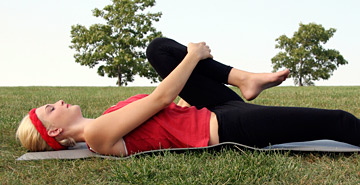To Your Health
May, 2010 (Vol. 04, Issue 05) |
|
|
How to Do It: Lie face-down on the floor, arms bent at your sides (sort of like a starting push-up posture). Straighten your arms up slowly, lifting your upper body off the floor as you do so.
Your legs and feet should stay on the ground. Hold for 3-5 seconds, then slowly lower your upper body back down. Repeat 10 times, as often as once per hour.
If your pain or restriction is on one side, a variation on McKenzie extension (lying on a raised surface with one leg on the floor, slightly bent) may be more comfortable (keep the elevated leg straight).
Flexion Exercises (bringing the leg toward the chest). People with lower back pain can also feel better with various types of leg flexion, bringing the bent leg toward the chest, or doing contract-relax and then bringing the bent leg toward the chest. These people usually have sacroiliac joint problems. (The SI joints are located on either side of the spine in the lower back.) These are also called Tigny exercises.
How to Do It: Lie on your back with one leg bent and then other flat on the floor. Bring the bent leg up toward the chest. Wrap your arms around the leg and then try to lower it toward the floor for 3-5 seconds, resisting with your arms. Relax, and then pull the bent leg up farther toward the chest. Repeat the entire process three times.
 Flexion exercises are another great way to relieve lower back pain. Lie on your back with one leg bent and the other leg flat on the floor. Raise the bent leg toward the chest, wrap your arms around the bent leg, and then try to lower it toward the floor as you resist with your arms. Repeat with the opposite leg.
I have included a series of links at the end of this article; the first two go to videos describing the basics of McKenzie extension. The third one goes to an article I wrote describing the basic McKenzie extension exercise, and a couple of other variations. The fourth link goes to Dr. Craig Liebenson's site, LA Sports and Spine, where you can download his article and pictures on McKenzie self-treatment for sciatica. The fifth and sixth links relate to the Tigny flexion exercises, including a one-minute video demonstration.
Flexion exercises are another great way to relieve lower back pain. Lie on your back with one leg bent and the other leg flat on the floor. Raise the bent leg toward the chest, wrap your arms around the bent leg, and then try to lower it toward the floor as you resist with your arms. Repeat with the opposite leg.
I have included a series of links at the end of this article; the first two go to videos describing the basics of McKenzie extension. The third one goes to an article I wrote describing the basic McKenzie extension exercise, and a couple of other variations. The fourth link goes to Dr. Craig Liebenson's site, LA Sports and Spine, where you can download his article and pictures on McKenzie self-treatment for sciatica. The fifth and sixth links relate to the Tigny flexion exercises, including a one-minute video demonstration.
So, here is the bottom line: When your lower back starts to hurt, find one or more simple movements or exercise that helps. Do the exercise over and over until you are back to normal. If you are not getting better quickly, call your chiropractor.
With that said, please use common sense. Stop immediately is you hurt more during or after doing any exercise. Exercise is not without risks. These or any other exercises may cause pain or injury. As with any exercise program, if at any point during your routine you begin to feel faint, dizzy, or have physical discomfort, you should stop immediately. To reduce your risk of injury, consult with your doctor before doing these exercises for the first time, particularly if your pain is new and/or you would like further explanation of how to perform the exercises correctly.
Links to Exercise Demonstrations and More Information
Marc Heller, DC, maintains a chiropractic practice in Ashland, Ore. He is a nationally recognized expert in treating tailbone, sacroiliac and lower back pain.

